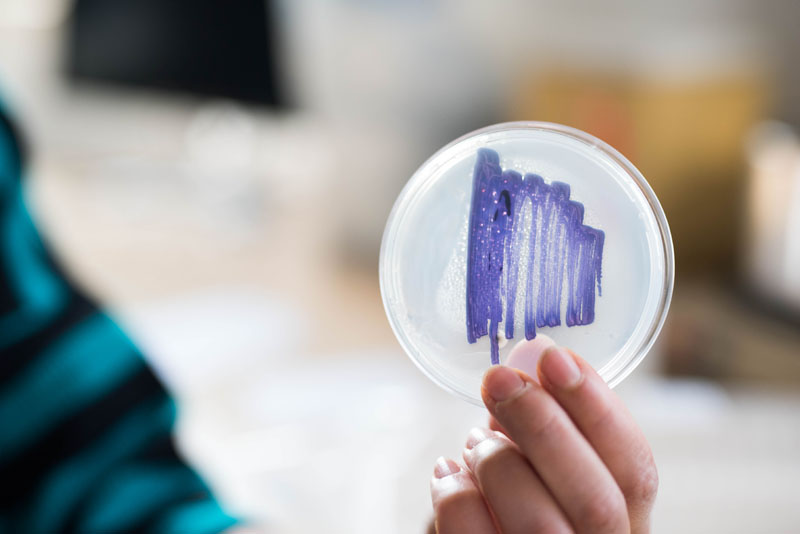Waag open wetlab
Issue: XXV.5 September-October 2018Page: 18
Digital Citation
Authors:
Lucas Evers
Editors' note: For this Day in the Lab, we look outside HCI to a bioscience and biodesign lab to see similarities in practice. Approaches that we associate with HCI are becoming more widespread, as other disciplines embrace participatory approaches. This bodes well for emerging areas such as biodesign, since the gap is narrowing between HCI and some recent disciplinary colllaborators.
How do you describe your lab to visitors? The Open Wetlab at Waag in Amsterdam is a laboratory for creating biotechnologies from a public perspective. Waag's core values are openness, fairness, and inclusivity. Our lab tests and develops biotechnologies (like CRISPR Cas9) in a way that both remains true to these core values and increases public understanding of the potential of biotechnologies. We offer artists, designers, and scientists a space to conduct experiments under the requirements of biosafety—with the help of our own appointed biosafety officer. We are convinced that by doing this, we provide our audience with a value-oriented (rather than technology-focused) vision of emerging technologies.
What is a unique feature of your lab? It's the only lab at Waag that has a lock and a key. I just mentioned Waag's core value of being open, so this lab is open, but on the condition of maintaining biosafety. We work with the newest gene-editing techniques, but we can do that only if we provide a situation that is safe. Safe not only for the environment, practitioners, and organisms, but also safe in the way that all participants are allowed to voice their opinions about those technologies. The lab is closed when no authorized colleagues are there because we do work with microorganisms and certain low-grade pathogens.
How many people are in the lab, and what is the mix of backgrounds and roles? At Waag we have a number of research groups containing six to 12 people each, and we work with a group of research fellows in addition to that. In the lab itself, we have a setup allowing us to work with the most basic microbiology techniques, but we also collaborate with people from all over the world. For example, I'm currently developing an adipose tissue-culture project with a cardiovascular tissue-culture expert in New York, and I've brokered lab space at the Hubrecht Institute for a visiting artist from Australia to grow his own brain tissue. Apart from having a physical laboratory, the Wetlab, we are a virtual laboratory that is part of a network of people from other laboratories that one can potentially work with.
Briefly describe a day in the life of your lab. We have students coming in for the BioHack Academy throughout the day. During this 10-week course, we teach people how to set up and make their own microbiology lab. In between the classes, we give tours of our facilities to visiting artists and researchers who want to know a bit more. In the evening, we have another workshop where an artist teaches the general audience how to work with tissue cultures or in vitro meat. This means that sometimes we need to work around the clock.
What is one feature of your lab that you could not do without? We cannot do without the incubator because understanding what to grow and how to grow it is the start of every biotechnology project. For that reason, we introduce most people interested in working at the Wetlab to microbiology. To culture microorganisms you need an incubator. We actually started off with incubators we bought at a pet shop, used for hatching reptile eggs. At the same time, we have a lot of do-it-yourself types who make their own incubators and other hardware at our lab, such as PCRs and microfluidics equipment.
What feature do you not have but would you like to have? We would love a DNA sequencer. Recently they have become more accessible, in that they are less expensive and more effective, which brings them closer to the do-it-yourself domain. DNA sequencers can tell us the exact order of the G, T, A, and C nucleotides of a DNA molecule, which can then be used for many diagnostic purposes. Commercial companies collecting human DNA sequences confront us with questions about the nature of the information generated by DNA sequencing. Who owns it? Should we create a novel agency concerned with where that information is kept? Is it still ours as citizens? I would love to work with a DNA sequencer much more in our lab, so that we can address these questions by doing, by making our own DNA sequences.
How would you describe how people interact in your lab? Responsibility is very important to the culture in our lab, which is characterized by its criticality and by our way of looking at the values behind current research in life sciences. In an era when we can make anything, the question is not what to make, per se, but how to make it. The same applies to the creation of new biotechnologies.
What is the one thing you see as most important about your work here? The most important thing is to create a culture of research, to show that research in essence is something that can be done by many—not only by scientists but also by artists, designers, and citizens. Biotechnologies hold a lot of promise, but they also spark public fear about ecological danger and the ownership of life. By stimulating research that is more diverse and built on a vision of collaboration between humans and non-humans, between society and ecology—by stimulating research that is reciprocal, we are convinced we can create biotechnologies that are more beneficial and meaningful to society and ecology.
http://waag.org/nl/labs/open-wetlab
https://academy.waag.org/en/programme/biohack-academy/
Copyright held by author
The Digital Library is published by the Association for Computing Machinery. Copyright © 2018 ACM, Inc.





